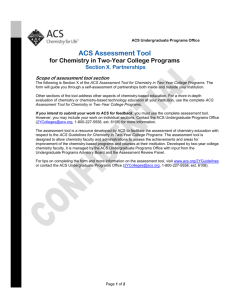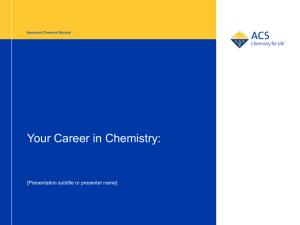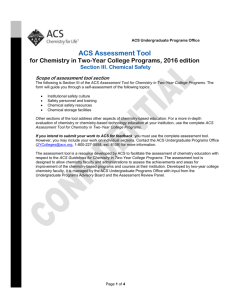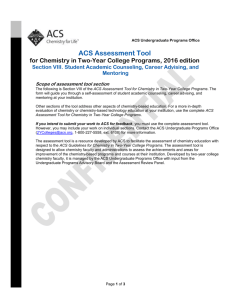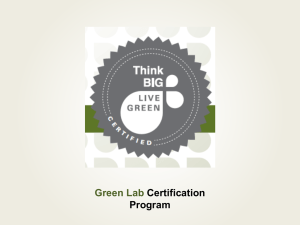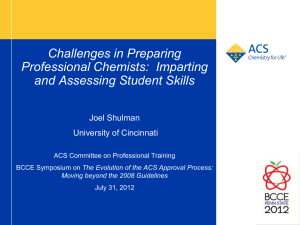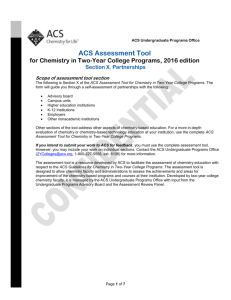American Chemical Society Self-Study Form for Chemistry in Two
advertisement
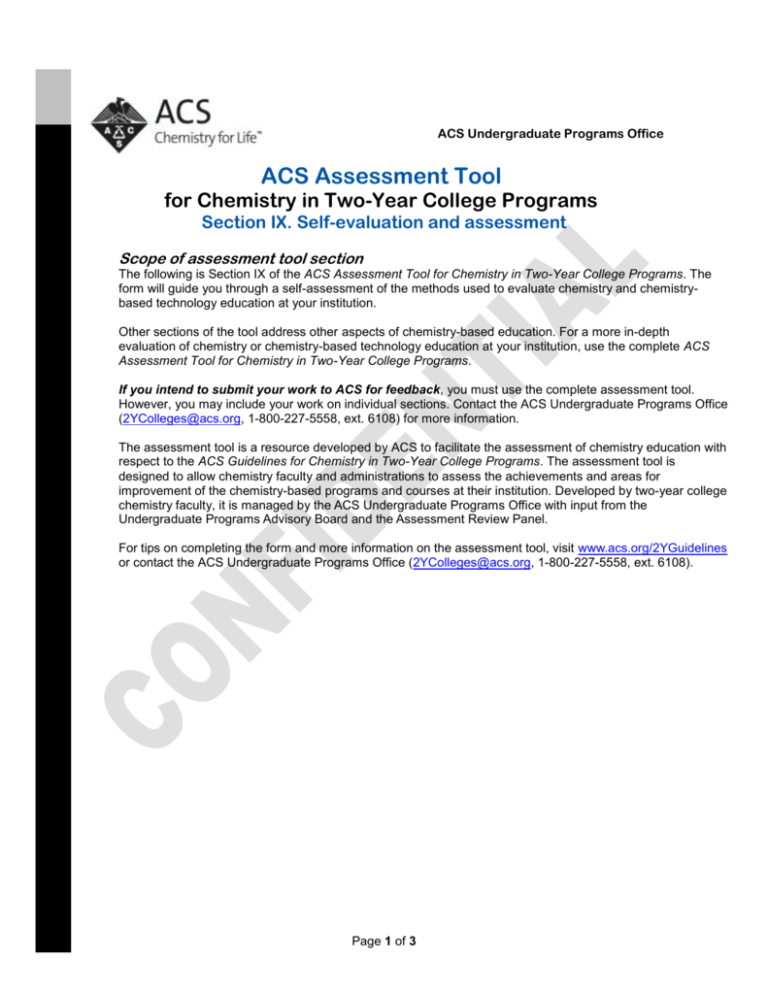
ACS Undergraduate Programs Office ACS Assessment Tool for Chemistry in Two-Year College Programs Section IX. Self-evaluation and assessment Scope of assessment tool section The following is Section IX of the ACS Assessment Tool for Chemistry in Two-Year College Programs. The form will guide you through a self-assessment of the methods used to evaluate chemistry and chemistrybased technology education at your institution. Other sections of the tool address other aspects of chemistry-based education. For a more in-depth evaluation of chemistry or chemistry-based technology education at your institution, use the complete ACS Assessment Tool for Chemistry in Two-Year College Programs. If you intend to submit your work to ACS for feedback, you must use the complete assessment tool. However, you may include your work on individual sections. Contact the ACS Undergraduate Programs Office (2YColleges@acs.org, 1-800-227-5558, ext. 6108) for more information. The assessment tool is a resource developed by ACS to facilitate the assessment of chemistry education with respect to the ACS Guidelines for Chemistry in Two-Year College Programs. The assessment tool is designed to allow chemistry faculty and administrations to assess the achievements and areas for improvement of the chemistry-based programs and courses at their institution. Developed by two-year college chemistry faculty, it is managed by the ACS Undergraduate Programs Office with input from the Undergraduate Programs Advisory Board and the Assessment Review Panel. For tips on completing the form and more information on the assessment tool, visit www.acs.org/2YGuidelines or contact the ACS Undergraduate Programs Office (2YColleges@acs.org, 1-800-227-5558, ext. 6108). Page 1 of 3 ACS Assessment Tool for Chemistry in Two-Year College Programs, 2015 edition Section IX. Self-evaluation and assessment IX. Self-Evaluation and Assessment See Section 9 of the ACS Guidelines for Chemistry in Two-Year College Programs, p. 19. 1. Are there clear, measurable, published learning outcomes for each chemistry and/or chemistry-based technology course? ☐ Yes ☐ No Provide any additional comments on learning outcomes: Click here to enter text. 2. Is formal self-evaluation of the chemistry, chemistry-based technology, and/or science program performed on a regular basis? ☐ Yes, self-evaluation is conducted every Choose an item. years. ☐ No 3. Identify whether the indicated components of your program are assessed, how often they are assessed, how the results are shared and whether the results are used to improve the program. Program Component Is this assessed? How often? Student learning/content mastery ☐ Yes ☐ No Choose an item. What tools are used? Click here to enter text. Student skills (i.e., assessment of those components described in section VII) ☐ Yes ☐ No What tools are used? Click here to enter text. Quality of teaching ☐ Yes ☐ No What tools are used? Click here to enter text. Choose an item. Choose an item. Who designs the assessment tools? (Check all that apply.) ☐ Instructor ☐ Department or division ☐ Institution ☐ Third body external to the institution Who looks at the results? (Check all that apply.) ☐ Instructor ☐ Department or division ☐ Institution ☐ Third body external to the institution ☐ Instructor ☐ Department or division ☐ Institution ☐ Third body external to the institution ☐ Instructor ☐ Department or division ☐ Institution ☐ Third body external to the institution ☐ Instructor ☐ Department or division ☐ Institution ☐ Third body external to the institution ☐ Instructor ☐ Department or division ☐ Institution ☐ Third body external to the institution Page 2 of 3 ACS Assessment Tool for Chemistry in Two-Year College Programs, 2015 edition Section IX. Self-evaluation and assessment Program Component Is this assessed? How often? Pedagogy ☐ Yes ☐ No Choose an item. What tools are used? Click here to enter text. Program goals and objectives ☐ Yes ☐ No What tools are used? Click here to enter text. Student performance at their next academic institution ☐ Yes ☐ No What tools are used? Click here to enter text. Other (specify): Click here to enter text. ☐ Yes ☐ No What tools are used? Click here to enter text. Choose an item. Choose an item. Choose an item. Who designs the assessment tools? (Check all that apply.) ☐ Instructor ☐ Department or division ☐ Institution ☐ Third body external to the institution Who looks at the results? (Check all that apply.) ☐ Instructor ☐ Department or division ☐ Institution ☐ Third body external to the institution ☐ Instructor ☐ Department or division ☐ Institution ☐ Third body external to the institution ☐ Instructor ☐ Department or division ☐ Institution ☐ Third body external to the institution ☐ Instructor ☐ Department or division ☐ Institution ☐ Third body external to the institution ☐ Instructor ☐ Department or division ☐ Institution ☐ Third body external to the institution ☐ Instructor ☐ Department or division ☐ Institution ☐ Third body external to the institution ☐ Instructor ☐ Department or division ☐ Institution ☐ Third body external to the institution 4. Describe the mechanisms in place for using assessment results to improve the program. Click here to enter text. Provide any additional comments on self-assessment of chemistry education. Click here to enter text. Page 3 of 3
